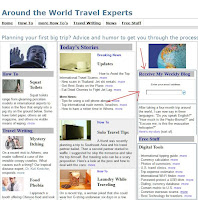Why Bother?
- You collect the names and e-mails addresses -- and you own them (not Facebook, Linked In, or Twitter).
- You can contact people directly via e-mail instead of waiting for them to view your posts.
- Historically, e-mail is supposed to elicit a higher response rate. (I.e. more people will buy your book or click your links.)
- You can collect names at parties, readings, and other face-to-face venues -- and add them manually. With a blog, you can add someone's e-mail address, but they have to verify that they want your blog or content, which, for many people, is an added hassle.
- Once your lists are set up, they're relatively easy to use.
- You don't have to post hourly, daily, or even monthly to stay in contact with people.
- Your hard-earned list is not subject to the vagaries and pricing schemes of social media sites.
Special Uses
- Create different e-mail lists for different types of subscribers. My blog covers a variety of topics ranging from humorous erotica to dating humor to travel to book marketing. Some experts say I should have a separate blog for each topic. Sorry. But by adding a sign-up box for different e-mail lists at the end of different types of articles, I can address different audiences. (For example, by posting a sign-up box, I can also see if anyone is interested in a particular topic. For example, if no one signs up for my "Humorous Erotica" newsletter, I won't write one.)
- On my blog, every month I have one or two people who sign up and for some reason don't verify their accounts, so they don't receive my blog. I've tried emailing, but some still have problems. I can just add them to an email list and forward by weekly blog feed to them.
How to Get Started
1) Create a List for Each Group of Contacts
- For small lists (less than 50 names), such as those who signed up for my blog but haven't been able to verify their accounts, I added their names to a "Lonely Planet" list I created in my Web e-mail service, which is Yahoo. Yahoo and most other Web-based e-mail services limit the number of people you can e-mail at one time.- For larger lists, such as my list of former co-workers and other acquaintances who may be interested in periodic (quarterly) updates on my book's progress, I use a free e-mail service, called MailChimp. The free version of the service, allows you contact up to 2,000 people six times a month. If I ever have more than 2,000 people, I will gladly pay a monthly fee.
- Cleaning up and uploading e-mails lists is a time-consuming process that can involve saving your e-mail contacts to another program and then uploading them to your e-mail service. I use Yahoo! Mail and went to my Contacts page and exported my contacts using the CSV option. (CSV is a format that you can edit in Excel and eliminate worthless contacts and stray information. I kept only First Name and Last Name (if I had them), and the E-mail address. Then I resaved the file as an CSV and upload it to Mail Chimp.)
 |
| I downloaded my contacts using the Yahoo! CSV option, which allowed me to edit the file in Excel. |
2) Create Content for Each Group
- The shorter the e-mail the better (My note to former co-workers and acquaintances will include a few highlights with links to a blog, a youtube video, and some publications.)- I started a real e-mail newsletter for people who attend my readings. (Even though my book isn't finished, I've reading scenes from it for years.) This newsletter includes three sections: Local reading events that may interest readers, some links to recent blog posts, and links to a few weird Web links.
3) How Often to Publish?
- I assemble and the newsletter mentioned above once a month. (I collect tidbits throughout the month and save them to a folder. Assembling the newsletter itself takes about two hours.)- For the note to colleagues, I'll send a plain e-mail quarterly or when I have big news.
- For the other topics (Humorous Erotica, Travel, etc), I'll publish monthly -- provided I get some people to sign up.
General Tips
- E-mail Services like Mail Chimp can track whether anyone actually opens your e-mail. If only a few people open it, you may want to resend it to people who didn't open it.- Experts say the best time to send out an e-mail is Tuesday through Thursdays between 11:00 a.m. and 3:00 p.m. Experts say a lot of stuff. You might want to experiment with different times to determine your best response rate.
- Did I mention to keep the newsletter short, include lots of white space, and links? E-mail services have basic templates you can use for a semi-professional look without a lot of grief.
- Offer a freebie for people who sign up. (A free story, a free e-book of writing samples.)
- To collect e-mails on your Web site or blog, you'll use a service like Mail Chimp to create a sign in box that allows people to add their e-mails. If possible don't use the word subscribe in the sign-in box -- people will assume they have to pay for something.
 |
| The sign-up box on my travel site does not include the word "subscribe," a word that implies you have to pay. |
For more information on e-mail and newsletters, here's a cheat sheet from E-Mail Marketing for Dummies.
*E-mail slingshot image at top of this blog by PCL-BO [CC-BY-SA-2.5], via Wikimedia Commons
Can't Get Enough Book Marketing?
- Three Ways to Boost Your Blog Traffic
- Linked In Tips for Authors
- Feeling Depressed? Be Glad Your Not a Guy: The End for Men
